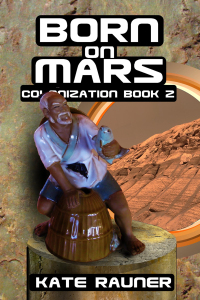Kate Rauner's Blog, page 78
December 10, 2015
Space Miners Own What They Dig :) #space #shipment #science

This asteroid has its own moon
Who says the US Congress can’t get anything done? A new law confirms that whatever space miners bring home legally belongs to them. This may be obvious – like the international “high seas” where everybody and nobody owns the resource, and fishermen are free to go out and fish. Freedom is assumed and limitations must be enacted by international groups like the UN.
If Congress’s concern seems premature, consider that companies want some assurances before they invest big dollars in the space industry. I wonder what premium people will pay for a ring of asteroid gold? Or maybe, it’s the rare technology metals that will pay the bills. popsci.com
Filed under: Neat Science News Tagged: asteroid, law of the sea, mining, space, US Congress








December 9, 2015
Life Is… #surprisingthing in #science #poetry

Newcomers hog the spotlight
Age of Fishes, Paleozoic,
Age of Reptiles, Mesozoic,
Age of Mammals, Cenozoic,
Age of Man, Anthropocene,
These all miss the major theme.
Outstanding feature of life’s scene
Is a constant domination,
Now, as ever since creation,
Reigning through life’s whole duration.
Count by biomass or cells,
Eon, epoch, era tells
In what period life dwells.
It’s the Age of Microbes!
It’s been the Age of Microbes.
Will always be,
On land and sea,
Earth in the Age of Microbes.
Poem by Kate Rauner
We humans are impressed by big, fierce creatures – but nature is not. “What you see is that the most outstanding feature of life’s history is a constant domination by bacteria.” Stephen Jay Gould
Filed under: Poetry Tagged: Anthropocene, bacteria, biology, Cenozoic, evolution, Mesozoic, Microbe, Paleozoic, poem, poetry, science, stephen jay gould








December 5, 2015
Will a #Mars Colony Survive? :O #scifi #Amazon #book
Yee ha :) My latest science fiction novel’s available – second in the On Mars series started by Glory on Mars. The Artificial Intelligence has grown up a bit, but the settlers are in trouble.
It’s bad luck to be born on Mars.
Welcome to the second book of the On Mars series, a story of our near-future. Journey with Jake, born in the first Martian colony, as he seeks help from the only other humans on Mars. But Earthers are as dangerous as the hostile planet.
The colonists need resources – metals and minerals – to survive, but their prospecting efforts have failed. A second generation Mars-born, Jake’s lucky to avoid the sicknesses that plague the settlement, but refuses to father any children in the doomed colony. He joins a team to explore beyond the Tharsis Plain, but his first trip ends in near-disaster.
Half a planet away, new-comers from Earth start a second colony, but refuse all attempts at communication. Jake, with his friend Martha, plots a way to contact them and perhaps find help for his family and friends. He continues to prospect despite the risk on Mars’ hostile surface, and waits for the enigmatic Sino-African colony to respond. But greater dangers await if they do.
Read this book to discover if humans can claim Mars as home.
Filed under: Kate's Books, Science Fiction Tagged: Africa, China, colonization, colony, exploration, mars, Martian, science fiction, SciFi, settlers








December 4, 2015
#Marijuana in #Space – should we take #weed with us?
 In my #scifi book Glory on Mars, settlers take cannabis seeds with them. It’s not a big part of the story, but at one point they need something to perk up their appetites and sooth despair – these are permanent settlers, not astronauts. I’m no expert on pot – should they grow it in a Mars colony? What strain should they take? BTW – I don’t let them smoke. I’m a volunteer firefighter – smoke is bad.
In my #scifi book Glory on Mars, settlers take cannabis seeds with them. It’s not a big part of the story, but at one point they need something to perk up their appetites and sooth despair – these are permanent settlers, not astronauts. I’m no expert on pot – should they grow it in a Mars colony? What strain should they take? BTW – I don’t let them smoke. I’m a volunteer firefighter – smoke is bad.
Filed under: Kate's Books, Neat Science News, Science Fiction Tagged: astronaut, cannabis, colonization, colony, marijuana, mars, Martian, Pot, settler, space








December 3, 2015
Do Spare Parts Doom a #Colony on #Mars? :( Or can we print our way to success? #MarsSurvivalTips
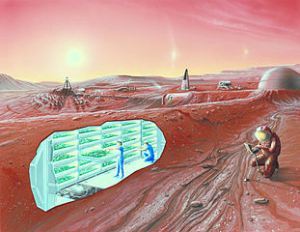
NASA concept of a Mars colony
In my #scifi books, Glory on Mars and Born on Mars, settlers have fancy 3D printers called fabricators, using lasers to sinter together almost anything. Giant robotic fabricators build their habitats while precision lab fabricators use metal foils to slowly construct any part they need. Lasers can even manipulate molecules or atoms, so they can make any crystal they want. But that’s science fiction.
One of MIT’s objections to the Mars-One plan for a permanent colony on the red planet is spare parts. As time goes on, spare parts for a growing colony would exceed the room in any plausible sized spacecraft.
Will 3D printing save the day?
NASA is working on this in the International Space Station – a way to make many different spare parts, as needed, from one source of material.
But we Earth-bound humans use a lot of different materials. My town’s recycling instructions list seven types of plastic, aluminum, steel, and glass. And what’s in the light bulbs and electronics I have to handle separately?
High-end industrial printers sinter parts from certain metal and plastic powders, but there are a lot of materials that can’t be printed. And 3D printers can’t easily mix materials in one print job. Printing a hammer is easy, but parts that will move must be printed separately and assembled. Also, the parts aren’t as strong because of weakness between the layers.
On the plus side, while 3D printing looks expensive compared to traditional manufacturing, it looks pretty good compared to sending spacecraft to Mars.
If you’re a colonist on Mars you’ll live in a bubble of earthly environment, and if that bubble pops you’re dead in five minutes. Spare parts will be life-and-death items. The technology I sent to Mars in my books is still in the real-world’s future.
See more about Mars-One and the debate with MIT students.
Filed under: Kate's Books, Neat Science News, Science Fiction Tagged: 3D printer, additive manufacturing, colonization, colony, crystals, mars, Mars One, Martian, Massachusetts Institute of Technology, metals, MIT, plastics, science fiction, SciFi, spare parts








Do Spare Parts Doom a Colony on #Mars? :( Or can we print our way to success?

NASA concept of a Mars colony
In my #scifi books, Glory on Mars and Born on Mars, settlers have fancy 3D printers called fabricators, using lasers to sinter together almost anything. Giant robotic fabricators build their habitats while precision lab fabricators use metal foils to slowly construct any part they need. Lasers can even manipulate molecules or atoms, so they can make any crystal they want. But that’s science fiction.
One of MIT’s objections to the Mars-One plan for a permanent colony on the red planet is spare parts. As time goes on, spare parts for a growing colony would exceed the room in any plausible sized spacecraft.
Will 3D printing save the day?
NASA is working on this in the International Space Station – a way to make many different spare parts, as needed, from one source of material.
But we Earth-bound humans use a lot of different materials. My town’s recycling instructions list seven types of plastic, aluminum, steel, and glass. And what’s in the light bulbs and electronics I have to handle separately?
High-end industrial printers sinter parts from certain metal and plastic powders, but there are a lot of materials that can’t be printed. And 3D printers can’t easily mix materials in one print job. Printing a hammer is easy, but parts that will move must be printed separately and assembled. Also, the parts aren’t as strong because of weakness between the layers.
On the plus side, while 3D printing looks expensive compared to traditional manufacturing, it looks pretty good compared to sending spacecraft to Mars.
If you’re a colonist on Mars you’ll live in a bubble of earthly environment, and if that bubble pops you’re dead in five minutes. Spare parts will be life-and-death items. The technology I sent to Mars in my books is still in the real-world’s future.
See more about Mars-One and the debate with MIT students.
Filed under: Kate's Books, Neat Science News, Science Fiction Tagged: 3D printer, additive manufacturing, colonization, colony, crystals, mars, Mars One, Martian, Massachusetts Institute of Technology, metals, MIT, plastics, science fiction, SciFi, spare parts








December 2, 2015
Pyrophobia in America – #poetry by Kate Rauner
We’ll spend a lot of money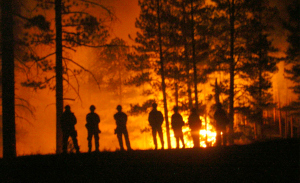
And casualties will grow,
Yet we’ll lose the battle
When fire is our foe.
We’re not the temperate forests
Of managed German parks.
Native people knew the truth
That now appears so stark.
The forests and the prairies
Of the New World’s endless lands
Evolved in step with fire,
Pyro-climatic grand.
Now like a threatened species,
It’s lost its habitat,
But unlike frogs or butterflies
Fire will roar back.
Summer heat is rising,
Drought spreads across the land,
Insects bore into the trees,
And fire makes its stand.
We now leave nature’s fires to burn
When fighting is futility.
It will take decades to reverse
The hubris of a century.
Severe fires visit America’s parks and forests every year. We’re learning about the role fire plays in these natural ecosystems, but still must protect lives and homes. Climate change only makes fire harder to manage. Articles on fire management pop up frequently, like this one.
Filed under: Poetry Tagged: fire fighter, forest management, prairie, pyroclimatic ecosystem, Wild fire








November 28, 2015
First Cat on #Mars :)
 In #scifi Glory on Mars, a cat joins settlers on Mars as a welcome diversion from the battle for survival, and eventually plays an important role in the settlers’ struggle. His earthly stand-in – Harvey – appears on the book’s cover. Harvey’s taking his notoriety in stride.
In #scifi Glory on Mars, a cat joins settlers on Mars as a welcome diversion from the battle for survival, and eventually plays an important role in the settlers’ struggle. His earthly stand-in – Harvey – appears on the book’s cover. Harvey’s taking his notoriety in stride.
In the story, two men and two women, about to join the first eight settlers on Mars, have a farewell party at Spaceport America:
Unexpectedly, Emma felt a wave of panic battle the tequila in her bloodstream. She’d had phones and tablets, games and links for as long as she could remember. But batteries were a luxury on Mars, used only for necessary applications. All her earthly devices would be left behind.
One by one, with laughing and back-slapping, the crew of the
Settler Three Mission relinquished their devices. Contact lenses were popped out and snapped into cases, earpieces and pads dropped into a box.
“We don’t leave our intrepid settlers out of touch,” the support lead shouted over the crowd. He passed Emma a hand-sized pad. With a cord. An electric power cord. And then he handed her an extension cord.
Emma stared at them. Of course, she used corded pads in training, but the permanence of surrendering her own devices hit home. She wandered towards the edge of the crowd, to the ballroom wall, and plugged into an outlet.
Her pad powered up immediately and, already set to Emma’s account, popped open a message.
“Hey! I’ve got a message from Mars,” she called out. People nearby turned towards her and the room quieted when they saw her puzzled face.
“The colonists want a cat.”
“What?” The support lead tumbled off his chair in confusion.
“They want us to bring them a cat.” Emma held up the pad, hitting the end of the power cord.
“You mean a pet-bot?” someone asked.
“No. A real, live cat. They say they’ve arranged for a kitten to be delivered to our ship from Lunar Base.”
Fuzzy with margaritas, Emma was perplexed. Maybe the settlers on Mars were going crazy.
Harvey’s adorable, of course, but colonizing a hostile planet is not.
Their one-way journey to Mars may be a mistake. The colony psychologist, one of the first eight settlers, has committed suicide. Four more settlers are now on their way, bringing renewed hope. Emma volunteered so she could explore Mars in her robotic walkabout suit. Even if she gets the chance, that may not make up for everything she left behind. Mars is a hostile planet, an inexplicable sense of desolation cripples their efforts, and danger from Earth follows them.
Read about the first colony on Mars for free. Use coupon code XY35L for a free download from Smashwords.com (available in all the major e-formats) through 2015. Or purchase from Amazon here.
There’s more about my books here.
Please post a review on Amazon, Goodreads, Booklikes, your favorite retailer, your blog, or wherever you hang out. Thanks!
Filed under: Kate's Books, Science Fiction Tagged: #FridayRead, #onmars, #sciencefictionbook, cat, colonization, colonize, colony, coupon code, cute cat meme, freebie, mars, science fiction, science fiction book, tabby








November 27, 2015
Practice for #Mars – Eat Like a Martian at Home #MarsSurvivalTips
 In my book Glory on Mars, Martian colonists grow their own food – including mealworms, which have as much protein as beef. So I was pleased to discover you can try this yourself at home.
In my book Glory on Mars, Martian colonists grow their own food – including mealworms, which have as much protein as beef. So I was pleased to discover you can try this yourself at home.
Harvest enough mealworms to replace traditional meat in four or five dishes – right on your desk or countertop… fry them up or mix them into soup, smoothies, or bug-filled burgers.
Fried mealworms are a treat for colonists in science fiction – and they need a 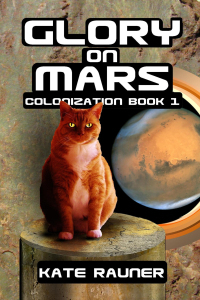 treat, because taking a one-way trip to Mars may be a mistake.
treat, because taking a one-way trip to Mars may be a mistake.
Interested? Check out livinfarms. Thanks to fastcoexist for the tip.
More ways to eat like a Martian:
fish supper
mealworm snack
Martian colony demonstration
Filed under: Kate's Books, Neat Science News, Science Fiction Tagged: colonization, colony, eat like a martian, ebook, mars, mealworms, novel, science ficiton, SciFi, space








November 26, 2015
Is a One-Way Trip to #Mars Crazy? :( Is it #SciFi? :)
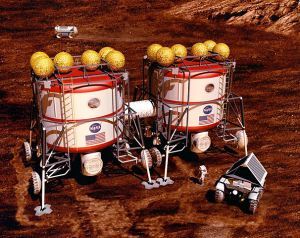
NASA concept Photo ID: S93-45586
Mars-One is a Dutch not-for-profit planning to establish a permanent colony on Mars. They’ve selected candidates to train for the one-way trip in five or ten years. Is that insane?
Problems to overcome
They say their settlers will land a ship using retro rockets in a configuration never tried before, and no one’s ever landed such big payloads.
Science won’t be their focus, colonization will – but how do you learn to live off the Martian land without a lot of specialized science?
Going to Mars, even one-way, will cost a lot – really, really a lot. Mars-One will raise the billions needed using the Olympics as a model – ad revenue, broadcast rights, and donations.
MIT students studied colony plans and found even simple things like CO2 versus O2 balance for the plants and humans don’t compute. That Mars-One hasn’t planned enough time or money to develop their missions. And they doubt a colony could become self-sustaining anytime soon.
In my scifi book, Glory on Mars, the first colony is further in the future than Mars-One, and I give my settlers some neat technologies – robots to build the settlement, an Artificial Intelligence, and satellite systems complete with an orbiting energy station to beam power to the surface. That’s still not enough to prevent disasters.
View the physicsfocus article and Mars-One web site. More about the MIT study here including a video of their debate with Mars-One founders. More about my books here.
Filed under: Kate's Books, Neat Science News, Science Fiction Tagged: colonize, colony, mars, Mars One, MIT, NASA, science fiction, SciFi, settle, space technology









